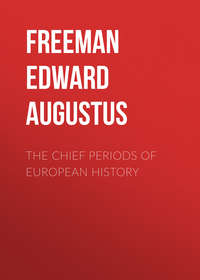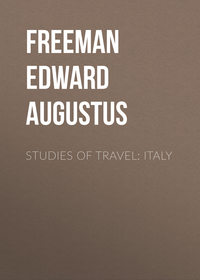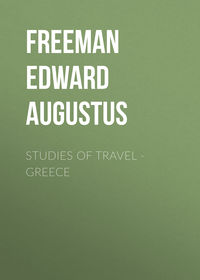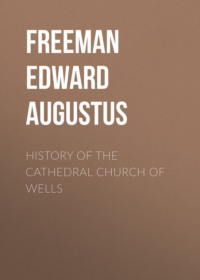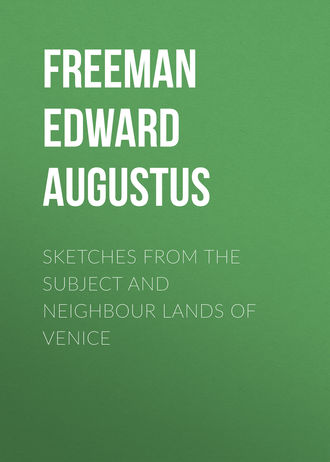 полная версия
полная версияSketches from the Subject and Neighbour Lands of Venice
In such a voyage as this many points necessarily escape notice, and the great objects of study are well reserved for the return journey. In all travelling for instruction's sake, it is a point specially to be insisted on that every place should, whenever it is possible, be seen twice. Nothing fixes a thing so well in the memory as going through the process of recollection. And, in such a voyage as this, it is no bad way to go at once to the furthest point, to see on the way so much of the several points as the arrangements of the steamers allow, and to stop a longer time at the important places coming back. In this way a general notion of Dalmatia and its cities is gained first of all – a notion which may be enlarged and corrected by more minute examination of the chief places, and of course, foremost among them, of Spalato itself. But Spalato, though the great object of a Dalmatian voyage, is by no means its final object. When we have reached Spalato, we have not yet gone through half our course. Before we can come back to study its wonders more worthily, we have to spend a day in the archipelago of larger islands, nearly each of which, unlike their northern fellows, has some old historical memory. We have for part of another day to sail along that still narrower strip of Christendom which fences off Ragusa from the Mussulman, to thread our way through the lovely Bocche of Cattaro, till we reach the furthest of Dalmatian cities, with the path to unconquered Montenegro over our heads.
PARENZO
1875Parenzo, the ancient colony of Parentium, is likely to be, for many travellers in Istria and Dalmatia, their first point of stoppage after leaving Trieste. To such travellers it will be the beginning of the dominion of Venice in spots lying wholly beyond the Hadriatic, the first glimpse of the long series of lands and cities, from Istria to Cyprus, which once "looked to the winged lion's marble piles," and where the winged lion still abides in stone to keep up the memory of his old dominion. The short voyage is a lovely one. Looking back, there is Trieste on her hill-side, with her suburbs and detached houses spreading far away in both directions, and backed by the vast semicircle of the Julian Alps, with the snowy peaks of their higher summits soaring above all. The northern part of the Istrian peninsula, as we see it from the sea, has a strikingly rich and picturesque look, which is lost as we follow the coast towards the south. The small Istrian towns, each one of which has its civil and ecclesiastical history, jut out, each one on its own smaller peninsula; and in this part of the voyage the spaces between them are not lacking in signs of human dwelling and cultivation. Capo d'Istria, once Justinopolis, lies in its gulf to the left, to remind us that we have passed into the dominions of the Cæsars of the East. Forwards, Pirano stands on its headland, its duomo rising above the water on arcades built up to save it from the further effects of the stripping process which is so clearly seen along the coast. The castle, with its many towers capped with their Scala battlements, rises over town and church, with a picturesqueness not common in Italian buildings. The church, on the other hand, is as far from picturesque as most Italian churches are without, and the detached campanile is simply, like many other Istrian bell-towers, a miniature of the great tower of the ruling city. But neither Capo d'Istria nor Pirano is so likely to cause the traveller bound for Dalmatia to halt as the other and more famous peninsular town of Parenzo. Long before Parenzo is reached, the Istrian shore has lost its beauty, though the Istrian hills, now and then capped by a hill-side town, and the higher mountains beyond them, tell us something of the character of the inland scenery. At last the Parentine headland is reached; the temples which crowned it are no longer to be seen, but the campanile of the famous duomo, with its Veronese spire, and one or two smaller towers, have taken their place as the prominent objects of the little city. On the side which would otherwise be open to the Hadriatic, the isle of Saint Nicolas shuts in the haven guarded by a round Venetian tower. The other side of the peninsula is washed by the mouth – here we must not say the estuary – of a stream yellow as Tiber, which comes rushing down by a small waterfall from the high ground where the Parentine peninsula joins the mainland. On this peninsula stood the older municipium of Parentium, and the colony, some say the Julian Colony of Augustus, others the Ulpian Colony of Trajan. The zeal of Dr. Kandler, the great master of Istrian antiquities, made out the position of the forum, patrician and plebeian, of the capitol, the theatre, and the temples. The traveller will probably need a guide even to the temples, though one of them keeps the greater part of its stylobate, and the other one has two broken fluted columns left. A single inscribed stone in the ancient forum he can hardly fail to see; but the truth is that the Roman remains of Parentium are such as concern only immediate inquirers into local Parentine history. At Pola it is otherwise; there the Roman remains stand out as the great object, utterly overshadowing the buildings of later times; but at Parenzo the main interest, as it is not mediæval so neither is it pagan Roman. As at Ravenna, so at Parenzo, the real charm is to be found in the traces which it keeps of the great transitional ages when Roman and Teuton stood side by side. Against the many objects of Ravenna Parenzo has only to set its one. It has no palace, no kingly tomb – though the thought cannot fail to suggest itself that it was from Istrian soil that the mighty stone was brought which once covered the resting-place of Theodoric. Parenzo has but a single church of moment, but that church is one which would hold no mean place even among the glories of Ravenna. The capitol of Parentium has given way to the episcopal precinct, and the temple of the capitoline god has given way to the great basilica of Saint Maurus, the building which now gives Parenzo its chief claim to the study of those for whom the days of the struggle of Goth and Roman have a special charm.
As to the date of the church of Parenzo there seems little doubt. It is a basilica of the reign of Justinian, which has been preserved with remarkably little change, and which will hardly find, out of Rome and Ravenna, any building of its own class to surpass it. With the buildings of Ravenna it stands in immediate connexion, being actually contemporary with the work both at Saint Vital and at Saint Apollinaris in Classe. Its foundation is a little later, as the church of Parenzo seems to have been begun after the reconquest of Italy and Istria by Belisarius, while both Saint Vital and Saint Apollinaris, though finished under the rule of the Emperor, were begun under the rule of the Goth. There are points at Parenzo which connect it with both the contemporary churches of Ravenna. The pure basilican form, the shape of the apse, hexagonal without, though round within, are common to Parenzo and Classis; the capitals too have throughout the Ravenna stilt above them; but of the capitals themselves many take that specially Byzantine shape which at Ravenna is found only in Saint Vital. That the founder was a Bishop Euphrasius is shown by his monogram on many of the stilts, by the great mosaic of the apse, in which he appears holding the church in his hand as founder, and by the inscription on the disused tabernacle, which is engraved in Mr. Neale's book on Dalmatia and Istria. At Parenzo, as at Sebenico, Mr. Neale was in a serious mood; but, though he copied the inscription rightly or nearly so, he misunderstood it in the strangest fashion, and thereby led himself into much needless puzzledom. Euphrasius, according to Dr. Kandler, having been before a decurion of the town, became the first bishop in 524, when the Istrian bishoprics were founded under Theodoric. The church would seem to have been built between 535 and 543. The inscription runs thus: —
Famul[us]. D[e]i. Eufrasius. Antis[tes]. temporib[us]. suis. ag[ens] an[num]. xi. hunc. loc[um]. fondamen[tis]. D[e]o. jobant[e]. s[an]c[t]e. æc[c]l[esie] Catholec[e]. cond[idit].
The church was therefore begun in the eleventh year of the episcopate of Euphrasius; that is, in 535. Dr. Kandler prints, unluckily only in an Italian translation, a document of 543, the sixteenth year of Justinian, who appears with his usual titles, in which Euphrasius makes regulations for the Chapter, and speaks of the church as something already in being. Mr. Neale quotes from Coletti, the editor of Ughelli's Italia Sacra, part of a document in Latin which is obviously the same, but which is assigned to 796, the sixteenth year of Constantine the Sixth. The difference is strange; but the date of the document does not directly affect the date of the church, and, whatever be the date of either, Mr. Neale needlessly perplexed himself with the inscription. He says that the inscription commemorates a certain Pope John, and wonders that Euphrasius, who took part in the Aquileian schism about the Three Chapters – the Three Chapters which readers of Gibbon will remember – should record the name of a Pope with whom he was not in communion. But this difficulty is got rid of by the simple fact that there is nothing about any Pope John in the inscription. Mr. Neale strangely read the two words DO. IOBANT. – the words are carefully marked off by stops – that is, in the barbarous spelling of the inscription, DEO IVVANTE, into the four words "Domino Johanne Beatissimo Antistite." We therefore need not, in fixing the date of the church of Parenzo, trouble ourselves about any Popes. There can be no doubt that it is the work of Euphrasius, and that Euphrasius was one of those who opposed Rome about the Three Chapters. In any case, the duomo of Parenzo has the interest which attaches to any church built while our own forefathers were still worshipping Woden; and we may safely add that it has the further interest of being built by a prelate who threw off all allegiance to the see of Rome.
The church is indeed a noble one, and its long arcades preserve to us one of the most speaking examples of the forms of a great basilica. Every arch deserves careful study, because at Parenzo the capitals seem not to have been the spoil of earlier buildings, but to have been made for the church itself. Some still cleave to the general Corinthian type, though without any slavish copying of classical models. Animal forms are freely introduced; bulls, swans, and other creatures, are made to do duty as volutes; and when bulls and swans are set on that work, we may be sure that the Imperial bird is not left idle. Others altogether forsake the earlier types; it perhaps became a church built in the dominions of Justinian while Saint Sophia was actually rising, that some of its capitals should adopt the square Byzantine form enwreathed with its basket-work of foliage. But all, whatever may be their form in other ways, carry the Ravenna stilt, marked, in some cases at least, with the monogram of the founder Euphrasius. Happily the love of red rags which is so rampant on either side of Parenzo, at Trieste and at Zara, seems not to have spread to Parenzo itself, and the whole of this noble series of capitals may be studied with ease. The upper part, including the arches, has been more or less Jesuited within and without, but enough remains to make out the original arrangements. The soffits on the north side are ornamented like those in the basilica of Theodoric, a style of ornament identical with that of so many Roman roofs; above was a simple round-headed clerestory, and outside are the same slight beginnings of ornamental arcades which are to be seen at Saint Apollinaris in Classe. The apse, with its happily untouched windows and its grand mosaic, also carries us across to Ravenna. Besides the founder Euphrasius, we see the likeness of the Archdeacon Claudius and his son, a younger Euphrasius, besides Saint Maurus the patron and other saintly personages. Below is a rich ornament, but which surely must be of somewhat later date, formed largely of the actual shells of mother-of-pearl. The Bishop's throne is in its place; and, as at Ravenna and in the great Roman basilicas, mass is celebrated by the priest standing behind the altar with his face westward. Such was doubtless the usage of the days of Euphrasius, and in such an old-world place as Parenzo it still goes on.
But if, in this matter, Parenzo clings to a very ancient use, we may doubt whether, at Parenzo or anywhere else, the men who made these great apses and covered them with these splendid mosaics designed them to be, as they so often are, half hidden by the baldacchini which cover the high altar. Even in Saint Ambrose at Milan, where the apse is so high above the altar and where apse and baldacchino are of the same date, we feel that the view of the east end is in some measure interfered with. Much more is this the case at Parenzo, where the apse is lower and the baldacchino more lofty. But the Parenzo baldacchino, dating from 1277, is a noble work of its kind, and it is wonderful how little change the course of seven hundred years has made in some of its details as compared with those of the great arcades. The pointed arch is used, and the Ravenna stilt is absent; but the capitals, with their animal volutes, are almost the same as some of those of Euphrasius. Between the date of Euphrasius and the date of the baldacchino we hear of more than one consecration, one of which, in 961, is said to have followed a destroying Slavonic inroad; but it is clear that any works done then must have been works of mere repair, not of rebuilding. No one can doubt that the columns and their capitals are the work of Euphrasius, and by diligently peeping round among the mass of buildings by which the church is encumbered, the original design may be seen outside as well as in.
But the church of Parenzo is not merely a basilica; it has all the further accompaniments of an Italian episcopal church. West of the church stands the atrium, with the windows of the west front and the remains of mosaic enrichment rising above it. An arcade of three on each side surrounds the court, a court certainly far smaller than that of Saint Ambrose. Two columns with Byzantine capitals stand on each side; the rest are ancient, but those of the west side are a repair of the present king, or by whatever title it is that the King of Dalmatia and Lord of Trieste reigns on the intermediate Istrian shore. To the west of the atrium is the roofless baptistery, to the west of that the not remarkable campanile. We have thus reached the extreme west of this great pile of building, which, after all – such is the difference of scale between the churches of northern and southern Europe – reaches only the measure of one of our smallest minsters or greatest parish churches. The basilica of Parenzo, with all its accompaniments, measures, according to Mr. Neale's plan, only about 240 feet in length. But, if we have traced out those accompaniments towards the west, we have not yet done with those towards the east. A modern quasi-transept has been thrown out on each side, of which the northern one strangely forms the usual choir, much as in St. Peter's at Rome. These additions have columns with Byzantine capitals, like those in the atrium, copied from the old ones. But beyond this choir, and connected with the original church, is a low vaulted building of the plainest round-arched work, called, as usual, the "old church," the "pagan temple," and what not, which leads again into two chapels, the furthest having an eastern apse. Now these chapels have a mosaic pavement, and it is most remarkable that, below the pavement of the church, is a pavement some feet lower, which evidently belongs to some earlier building, and which is on the same level as the pavement of these chapels. It is therefore quite possible that we have here some remains of a building, perhaps a church, earlier than the time of Euphrasius. Between Constantine and Justinian there was time enough for a church to be built at Parentium and for Euphrasius to think it needful to rebuild it. Lastly, among the canonical buildings on the south side of the church is one, said to have been a tithe barn, with a grand range of Romanesque coupled windows, bearing date 1250. They remind us somewhat of the so-called John of Gaunt's stables, the real Saint Mary's Guild, at Lincoln. In short, so long as any traces are left of the style once common to all Western Europe, England and Italy are ever reminding us of one another.
Such is the church of Parenzo, and at Parenzo the church is the main thing. As we pass away, and catch the last traces of the church of Euphrasius rising above the little peninsular city, our thoughts fly back to the other side of the Hadriatic, and it seems as if the men who came to fetch the great stone from Istria to Ravenna had left one of the noblest basilicas of their own city behind them on the Istrian shore.
POLA
1875 – 1881After Parenzo the most obvious stopping-place on the Istrian shore will be Pola; and at Pola the main objects of interest for the historical student will be classed in an order of merit exactly opposite to those which he has seen at Parenzo. At Parenzo the main attraction is the great basilica, none the less attractive as being a monument of early opposition to the claims of the Roman see. Beside this ecclesiastical treasure the remains of the Parentine colony are felt to be quite secondary. At Pola things are the other way; the monuments of Pietas Julia claim the first place; the basilica, though not without a certain special interest, comes long after them. The character of the place is fixed by the first sight of it; we see the present and we see the more distant past; the Austrian navy is to be seen, and the amphitheatre is to be seen. But intermediate times have little to show; if the duomo strikes the eye at all, it strikes it only by the extreme ugliness of its outside, nor is there anything very taking, nothing like the picturesque castle of Pirano, in the works which occupy the site of the colonial capitol. The duomo should not be forgotten; even the church of Saint Francis is worth a glance; but it is in the remains of the Roman colony, in the amphitheatre, the arches, the temples, the fragments preserved in that temple which serves, as at Nîmes, for a museum, that the real antiquarian wealth of Pola lies.
There is no need to go into the mythical history of the place. Tales about Thracians and Argonauts need not be seriously discussed at this time of day. Nor can there be any need to show that the name Pola is not a contraction of Pietas Julia. Save for the slight accidental likeness of letters, so to say is about as reasonable as to say that London is a corruption of Augusta, or Jerusalem of Ælia. In all these cases the older, native, familiar, name outlived the later, foreign, official, name. When we have thoroughly cleared up the origin of the Illyrians and the old Veneti, we may know something of the earliest inhabitants of Pola, and possibly of the origin of its name. But the known history of Pola begins with the Roman conquest of Istria in 178 B.C. The town became a Roman colony and a flourishing seat of commerce. Its action on the republican side in the civil war brought on it the vengeance of the second Cæsar. But the destroyer became the restorer, and Pietas Julia, in the height of its greatness, far surpassed the extent either of the elder or the younger Pola. Like all cities of this region, Pola kept up its importance down to the days of the Carolingian Empire, the specially flourishing time of the whole district being that of Gothic and Byzantine dominion at Ravenna. A barbarian king, the Roxolan Rasparasanus, is said to have withdrawn to Pola after the submission of his nation to Hadrian; and the panegyrists of the Flavian house rank Pola along with Trier and Autun among the cities which the princes of that house had adorned or strengthened. But in the history of their dynasty the name of the city chiefly stands out as the chosen place for the execution of princes whom it was convenient to put out of the way. Here Crispus died at the bidding of Constantine, and Gallus at the bidding of Constantius. Under Theodoric, Pola doubtless shared that general prosperity of the Istrian land on which Cassiodorus grows eloquent when writing to its inhabitants. In the next generation Pola appears in somewhat of the same character which has come back to it in our own times; it was there that Belisarius gathered the Imperial fleet for his second and less prosperous expedition against the Gothic lords of Italy. But, after the break up of the Frankish Empire, the history of mediæval Pola is but a history of decline. It was, in the geography of Dante, the furthest city of Italy; but, like most of the other cities of its own neighbourhood, its day of greatness had passed away when Dante sang. Tossed to and fro between the temporal and spiritual lords who claimed to be marquesses of Istria, torn by the dissensions of aristocratic and popular parties among its own citizens, Pola found rest, the rest of bondage, in submission to the dominion of Saint Mark in 1331. Since then, till its new birth in our own times, Pola has been a falling city. Like the other Istrian and Dalmatian towns, modern revolutions have handed it over from Venice to Austria, from Austria to France, from France to Austria again. It is under its newest masters that Pola has at last begun to live a fresh life, and the haven whence Belisarius sailed forth has again become a haven in more than name, the cradle of the rising navy of the united Austrian and Hungarian realm.

PORTA GEMINA, POLA.
That haven is indeed a noble one. Few sights are more striking than to see the huge mass of the amphitheatre at Pola seeming to rise at once out of the land-locked sea. As Pola is seen now, the amphitheatre is the one monument of its older days which strikes the eye in the general view, and which divides attention with signs that show how heartily the once forsaken city has entered on its new career. But in the old time Pola could show all the buildings which befitted its rank as a colony of Rome. The amphitheatre of course stood without the walls; the city itself stood at the foot and on the slope of the hill which was crowned by the capitol of the colony, where the modern fortress rises above the Franciscan church. Parts of the Roman wall still stand; one of its gates is left; another has left a neighbour and a memory. At the north side of the capitol stands the Porta Gemina, leading from it to the amphitheatre. The outer gateway remains, a double gate-way, as its name implies, with three Corinthian half-columns between and on each side of the two arches. But here steps in a singular architectural peculiarity, one which reminds us that we are on the road to Spalato, and which already points to the arcades of Diocletian. The columns support an entablature with its frieze and cornice, but the architrave is wanting. Does not this show a lurking sign of what was coming, a lurking feeling that the arch itself was the true architrave? Be this as it may, there it stands, sinning, like so many other ancient works, against pedantic rules, but perhaps thereby winning its place in the great series of architectural strivings which the palace of Spalato shows us the crowning-point. The other arch, which is commonly known as Porta Aurea or Porta Aurata, conforms more nearly to ordinary rules. Here we have the arch with the coupled Corinthian columns on each side of it, supporting, as usual, their bit of broken entablature, and leaving room for a spandril filled in much the same fashion as in the arch of Severus at Rome. Compared with other arches of the same kind, this arch of Pola may certainly claim to rank amongst the most graceful of its class. With Trajan's arch at Ancona it can hardly be compared. That tallest and slenderest of monumental arches palpably stands on the haven to be looked at; while the arch of Pola, like its fellows at Rimini and Aosta, and like the arch of Drusus at Rome, is a real thoroughfare, which the citizens of Pietas Julia must have been in the daily habit of passing under. And, as compared with the arches of Rimini and Aosta, its design is perhaps the most pleasing of the three. Its proportions are better designed; the coupled columns on each side are more graceful than either the single columns at Rimini or the pair of columns which at Aosta are placed so much further apart. The idolater of minute rules will not be offended, as at Aosta, with Doric triglyphs placed over Corinthian capitals, and the lover of consistent design will not regret the absence of the sham pediment of Rimini. But it must be borne in mind that the arch of Pola did not originally stand alone, and that its usual name of Porta Aurea is a misnomer. It was built close against the golden gate of the city, whose name it has usurped. But it is, in truth, the family arch of the Sergii, raised in honour of one of that house by his wife Salvia Postuma. As such, it has a special interest in the local history of Pola. Ages afterwards, as late as the thirteenth century, Sergii appear again at Pola, as one of the chief families by whose dissensions the commonwealth was torn in pieces. If there is authentic evidence to connect these latter Sergii with the Sergii of the arch, and these again with the great Patrician gens which played such a part in the history of the Roman commonwealth, here would indeed be a pedigree before which that of the house of Paris itself might stand abashed.



